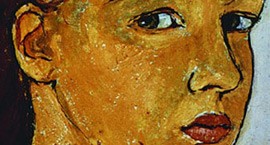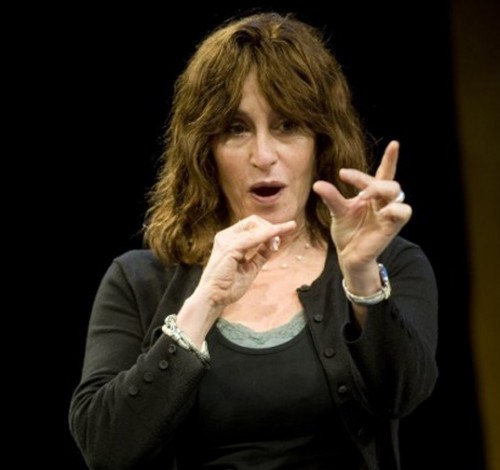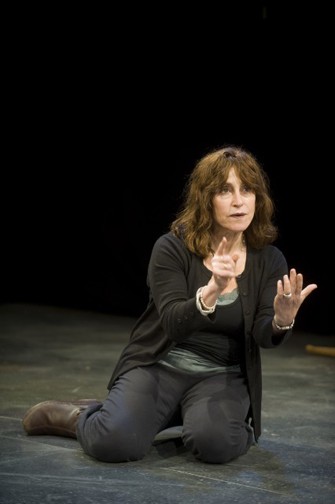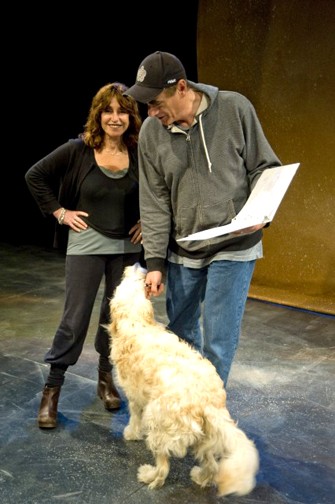Penelope Kreitzer in The Actors Rehearse the Story of Charlotte Salomon
Second Play in the Diva Series at Shakespeare & Company
By: Charles Giuliano - Jun 11, 2009
The Actors Rehearse the Story of Charlotte Salomon
By David Bridel, Penny Kreitzer and Jonathan Rest
Starring, Penny Kreitzer; Directed by Jonathan Rest; Set Design by Kiki Smith; Lighting Design by Greg Solomon; Sound design by Michael Peiffer and Jonathan Rest; Projection designer, Jonathan Rest; Stage Manager, Amelia Bales.
Shakespeare & Company
Elayne P. Bernstein Theatre
June 3-14, and September 12, 2009
Some years ago there was a densely crowded exhibition at Boston's Institute of Contemporary Art of narrative, somewhat primitive, today we use the term "outsider," works on paper by Charlotte Salomon(1917-1943) a German artist and writer. She fled Germany for the South of France to live with her grandmother shortly after Kristallnacht, November 9-10, 1938, an event which launched the Holocaust.
Prior to living in France she attended the Berlin State Art Academy (1935-1936). She was its only Jewish student. Before she and her husband, Alexander Nagler, were sent to Aushwitz in 1943, where, four months pregnant, she was murdered Charlotte created some thousand works of art. Just before they were arrested she gave a suitcase with the works to a neighbor, Dr. Moridis, stating "Keep these for me. It is my whole life." After the war they were recovered by her step mother and father, Paula Lindberg-Salomon, a renowned contralto and teacher, and Dr. Albert Salomon. Today they are a part of the permanent collection of the Joods Historisch Museum in Amsterdam.
Shortly after arriving in France her grandmother revealed to Charlotte her intention to commit suicide as had her mother and aunt. She conveyed to her granddaughter that she too was fated to take her life. Given the impending horrors of the Holocaust it was certainly a viable option and, indeed, she was ultimately murdered by the Nazis. But in a bold artistic decision Charlotte opted to embrace life all the more tenaciously and created a series of 769 works that together comprised a play in pictures "Leben? Oder Theater? Ein Singespiel (Life? Or Theatre? A play with music)."
A key character in the play was her first lover, Alfred Wolfson (1896-1962) a voice teacher with unique theories based on the trauma of hearing and being inspired by the vocal range and sounds of the dying during World War One. He was a difficult, deeply traumatized man and artist who inspired Charlotte to find her own voice in response to profound conflict and suffering. Wolfson may have had an affair with Charlotte's step mother who grew to loathe him. At the age of 99 Paula returned to Berlin for the first time where she was given a medal for artistic achievement as well as an official apology from the German government. She lived to the remarkable age of 103.
An attempt to produce Charlotte's play in Israel proved to be a disaster in no small part due to the interference of Paula who controlled the estate. She was adamant that Wolfson have no role in the production. The director, Joyce Miller, argued this was impossible as he was a key character in the narrative that Charlotte created. Paula also interrupted and tormented the actress, Kreitzer, who portrayed Charlotte. Miller unltimately abandoned the impossible task of directing an actress struggling to define her role, and Paua's demands and expectations. We are offered glimpses of that doomed rehearsal in process with projections of Charlotte's works as she had intended them to be seen.
It is the conflict of that ill fated attempt to stage the play in Israel which is the core of the aptly titled "The Actors Rehearse the Story of Charlotte Salomon." In that regard all of the characters, including the single actress who performs all of the roles, Penelope Kreitzer, are real and the complex work is based on actual events. Including those of Kreitzer who studied Wolfson's vocal techniques, while with the Roy Hart Theatre in 1973, and worked on the Salomon play as a member of the Jerusalem Drama Workshop in 1984.
In addition to developing as a superb actress, indeed Kreitzer's performance was riveting and masterful, the story of Charlotte Salomon, and the frustrations of bringing her picture play to life, evolved into an obsession that has taken years to realize. It has also entailed all of Kreitzer's artistic resources, initially three years of working with the writer, David Bridel, to develop the complex language of the play and the narrative of different characters. Two and a half years ago they were joined by Jonathan Rest, the director of the play, to bring it to its current form.
The result is a remarkable but daunting evening at Shakespeare & Company which has taken great risk to present such difficult work as a part of its Diva Series. The very fact that the company would take on such a project, during a time of enormous challenge for the arts, is a testament to remarkable commitment and artistic integrity. In an era of cutbacks, when the conventional wisdom is the play the hits, S&Co continues to take chances. For this they truly deserve our support. This work by Kreitzer, in a stunning performance, is a signifier of all that art can aspire to. It conveys the role that a magnificent company, with astonishing vision, assumes in presenting such work. Now, more than ever, we need the arts.
Not to say that this was an easy, comfortable, or enjoyable evening of theatre. The intent was not to entertain. Or even to present a documentary about Charlotte. Actually, her story is largely subsumed in the larger conflicts between Paula's autocratic interference, the director struggling to mount the production, and the frustrations of the actor portraying all of the characters. The complexities of shifting from one character and gestures to another required intense concentration that one would hardly describe as entertaining. The theme of the play is of course grim. There is no "Springtime for Hitler" chorus line to give a light touch to the horrors of war.
For all of these reasons this is not a production that audiences are flocking to. We were out of town last week during the opening. In general opening nights are well attended. Last night, the house was sparse but respectful and attentive. There was a consensus of sharing in a remarkable experience but confusion of just what to make of it.
Of course, this is just the kind of theater that I most enjoy; a challenging evening of art that makes me think and feel while never letting us off easy.
To some extent the play deepened the question I had arrived with. What about the artist Charlotte Salomon? That ICA show years ago had been disturbing and evasive. It just didn't fit comfortably into the context of contemporary art. I never understood what it was doing at the ICA. Actually I still don't know what to make of her work. This play provided no answers but moved me ever closer to understanding why Theodor Adorno argued that "writing poetry after Auschwitz is barbaric." Perhaps this is why her play proved to be impossible to produce in Israel and how this work which resulted from that disaster is such a conundrum.





